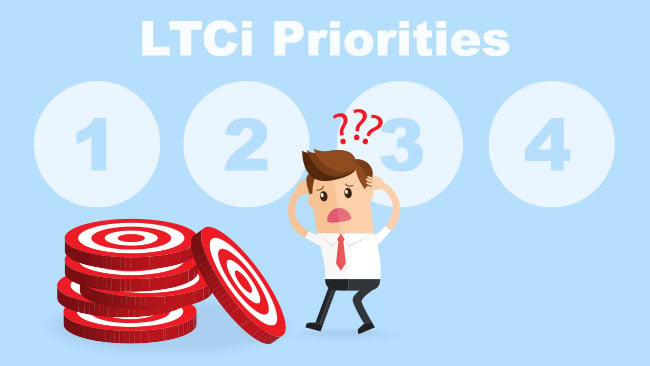It is important that financial professionals understand the financial product options that have the potential to provide financial resources to offset the cost of a long-term care event. However, it’s not enough just to understand what the options are…

You also want to be able to prioritize those options based on the type of client you’re working with and their specific needs and goals. In this post, we’ll walk you through options available and identify the client that would typically be a fit for each type of long-term care coverage.
- Standalone Long-Term Care Insurance
- Asset based Linked Benefit Products
- Traditional life insurance with chronic, critical, or true LTC riders
- GLWB annuity features increasing income during an LTC event
Standalone LTC insurance was the traditional method to cover this risk. In the 1990s it was affordable and provided excellent coverage. Today, this approach has suffered from escalating costs and more modest levels of coverage. Standalone coverage has waned in popularity and availability. This is mainly due to expense, the likelihood of increasing premiums, and the fact that if it is not needed, it is an unrecoverable expense. However, it can still be a viable choice for clients that have the other potential risks covered.
Linked Benefits are a newer breed of product that use either a life insurance policy or annuity contract to produce primarily LTC benefits. There are many benefits to this approach including stable or guaranteed premiums and the potential for a legacy if benefits are not fully accessed.
This style of coverage takes two forms either a reimbursement or a cash indemnity approach. The reimbursement system pays the amount of the actual receipts from a licensed care giver. The cash indemnity type pays a specified benefit amount that can be used for any purpose once the insured meets the requirements for benefit payment. Most plans offer coverage for 3, 5, or 6 years and one offers a lifetime extension of benefits rider at extra cost. Coverage is stated as a percentage of the specified amount and can also offer inflation protection. This approach would fit clients at or near retirement age whose main concern is LTC protection.
The modern breed of traditional life insurance policies whether whole life insurance, indexed universal life, universal life or term can provide significant coverage for long term care events while still fulfilling their primary function of providing a death benefit and perhaps cash accumulation or retirement income. These policies are less focused on the long-term care need and take three forms: Chronic Illness, Critical Illness, and true Long-Term Care coverage.
Of course, for true LTC coverage the producer needs an endorsement on his or her license. The LTC riders are offered at extra cost, are usually indemnity based and usually offer the highest level of protection. Chronic and critical illness riders are offered with no annual rider fee, rather the cost occurs when the rider is invoked. Chronic illness is the most broad-based protection with insured qualifying if they cannot perform 2 of the 6 activities of daily living (ADLs). Critical illness specifies specific health conditions that will invoke coverage. Some carriers offer as many as 18 or more covered conditions.
All chronic and critical illness riders have two things in common — 1) the amount of the payment is less than the amount of death benefit accelerated and 2) the amount is determined actuarily depending on the client’s age and the severity of the condition. This means that younger, less severely impaired insureds, get a lower percentage of the amount accelerated.
For example, an 80-year-old might get 90% of the amount accelerated where a 45-year-old might get only 50% of the amount accelerated. The acceleration is considered a withdrawal and reduces the death benefit. This alternative is best suited to younger healthy clients focused on substantial death benefit protection for their families and strong cash accumulation. Keep in mind, most life insurance policies require health underwriting and in some cases, financial underwriting. Each case is individually underwritten as the severity of medical conditions varies among individuals. Formal underwriting evaluation and pricing is based on the individual characteristics of each case.
In dealing with clients in the pre-retirement or retirement segment of the population, we often find that these clients are at an age where they could have medical issues which prevent the use of a life insurance-based solution. Fixed Indexed Annuities can help in these scenarios. Most accumulation-oriented annuities have exceptions to contingent deferred sales charges after the contract is held for one year and the annuitant is in a long-term care facility for 90 days. If the client is purchasing an annuity that has a Guaranteed Lifetime Withdrawal Benefit (GLWB) or Guaranteed Lifetime Income Benefit (GLIB) rider for an income stream they cannot outlive, there are a number of carriers that provide an enhanced benefit for chronic illness.
Typically, these products offer what is called a doubler. So, if the annuitant cannot complete 2 of the 6 ADLs the income benefit is doubled for up to 5 years and then it drops back to original amount. These enhanced benefits can provide significant financial support, but it is important to recognize that the enhanced benefit will only be available as long as there is accumulation value in the policy. In other words, even though the benefit base continues to produce income through the GLWB or GLIB rider when the contract or accumulation value reaches zero, the enhanced benefit stops. Depending on strategy performance, the accumulation value can be exhausted in as little as 14 to 15 years. The typical annual cost for these income riders is around 95 basis points. This solution is ideal for pre-retirement age clients whose main objective is to obtain a lifetime income with the potential for additional funds if an LTC event occurs.
Every client has different needs and a different financial situation. For clients primarily focused on solving the LTC need in an efficient way that still provides a potential legacy, the Linked Benefits products are at the top of the heap. For clients looking for tax-free retirement income and a substantial legacy for their loved ones, the new breed of life insurance policies could be a good choice. Lastly, for clients looking for stable retirement income who may be older or have medical issues the lifetime income rider with an enhancement provision on an annuity can provide added chronic illness protection.
If you found this blog post helpful, please like or share. Or better yet, subscribe by entering your name and email address below.





